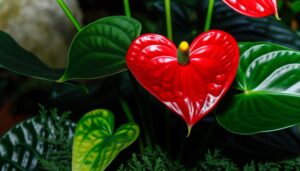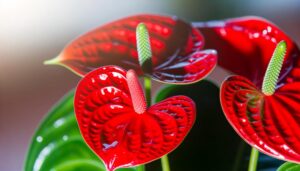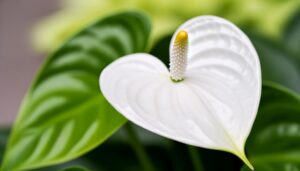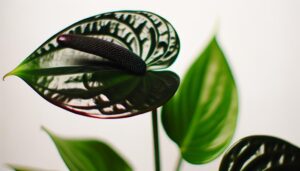Caring for Anthurium and Red Aglaonema: A Beginner's Guide
Caring for Anthurium and Red Aglaonema requires attention to their specific needs. Both thrive in bright, indirect light and should be kept in well-draining soil.
Maintain temperatures between 65-80°F and humidity levels around 60-80%. Water Anthurium regularly to keep soil moist, while Red Aglaonema prefers slightly drier conditions.
Use a balanced, water-soluble fertilizer every 4-6 weeks during active growth. Regular pruning and repotting every 1-2 years help sustain plant health.
Vigilant pest control and monitoring for issues like root rot and nutrient deficiencies are crucial. Further insights into these practices will ensure thriving plants.
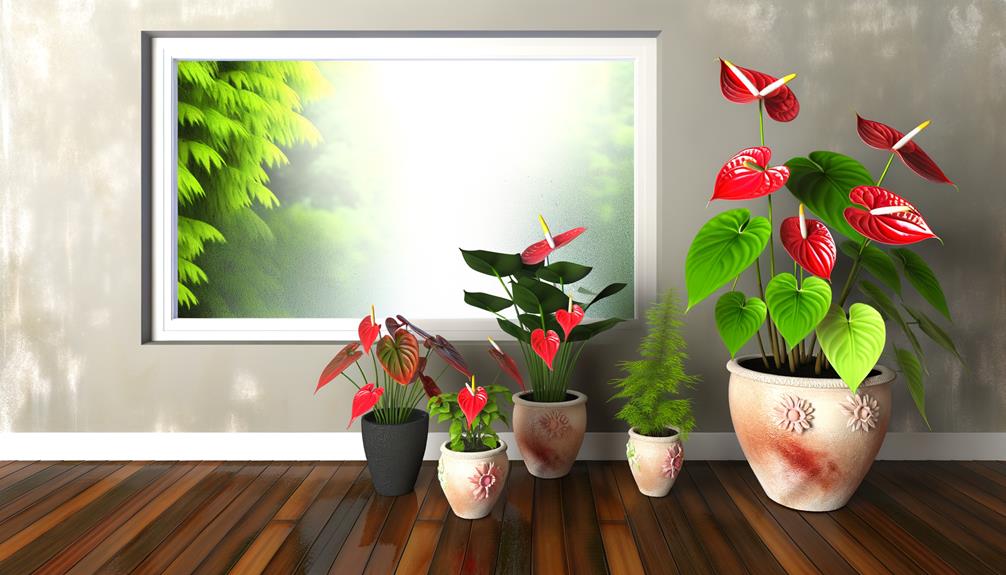
Key Takeaways
- Place plants in bright, indirect light to mimic tropical forest conditions.
- Water Anthurium when soil is moist and Red Aglaonema when soil is slightly dry.
- Maintain temperatures between 65-80°F and humidity levels between 60-80%.
- Use well-draining, aerated soil with a pH between 5.5 and 6.5.
- Apply diluted, balanced fertilizer every 4-6 weeks during active growth periods.
Light Requirements
Anthurium and Red Aglaonema, both tropical plants, generally thrive in bright, indirect light to maintain their vibrant foliage and overall health. Direct sunlight can cause leaf scorch, resulting in discoloration and potential long-term damage. Ideal light conditions mimic their native tropical environments, where sunlight is filtered through the forest canopy.
Place these plants near east or north-facing windows to provide adequate light without direct exposure. Artificial grow lights can supplement natural light, particularly in low-light indoor settings or during short winter days. Monitor leaf color and growth patterns; pale or leggy growth indicates insufficient light, while brown edges suggest excessive light. Adjust positioning accordingly to prevent adverse effects and promote robust growth.
Watering Schedule
Establishing an ideal watering schedule for Anthurium and Red Aglaonema is vital for their health, requiring careful attention to watering frequency and recognition of overwatering symptoms.
Equally important is the quality of water used, as impurities can negatively impact plant growth.
This section will outline the best practices to guarantee these plants receive the precise hydration they need.
Optimal Watering Frequency
To maintain the health of both Anthurium and Red Aglaonema, it is crucial to establish a precise watering schedule that takes into account their distinct moisture requirements and environmental conditions.
Anthuriums thrive in consistently moist, well-draining soil and should be watered when the top inch of soil feels dry to the touch. In contrast, Red Aglaonemas prefer slightly drier conditions; water them once the top two inches of soil are dry.
Seasonal adjustments are crucial: reduce watering frequency in winter when plant growth slows. Temperature, humidity, and potting medium also influence watering needs, necessitating periodic reassessment.
Consistent monitoring and adjustment guarantee that each plant receives the best moisture for robust growth and health.
Recognizing Overwatering Signs
Overwatering, a common issue for both Anthurium and Red Aglaonema, can be identified through several key indicators that reflect the plant's overall health and soil condition. Recognizing these signs early is essential to prevent root rot and other detrimental effects.
Symptoms of overwatering include:
- Yellowing Leaves: Chlorosis due to inadequate oxygen in the root zone.
- Wilting: Despite moist soil, leaves appear limp and lifeless.
- Mushy Stems: Stems become soft and may show signs of decay.
- Foul Odor: A musty or rotten smell emanating from the soil.
- Mold Growth: Visible mold or fungi on the soil surface.
Monitoring these signs can help maintain an ideal watering schedule, ensuring healthy growth for your Anthurium and Red Aglaonema.
Water Quality Importance
Ensuring the use of high-quality water is essential for the best health and growth of Anthurium and Red Aglaonema, as impurities can significantly impact soil composition and plant well-being. Tap water, often containing chlorine, fluoride, and excessive salts, may result in nutrient imbalances and root damage. It is advisable to use distilled or rainwater, which is free from these pollutants.
Additionally, allowing tap water to sit for 24 hours before use can help reduce chlorine levels. Monitoring the pH level, ideally between 5.5 and 6.5, guarantees optimal nutrient absorption. Regularly check for water hardness; soft water is preferred, as hard water can cause mineral buildup.
Maintaining high water quality supports strong growth and vibrant foliage.
Soil Preferences
Understanding the soil preferences for Anthurium and Red Aglaonema is essential for their best growth. Both species require a well-draining, aerated medium with specific pH level requirements to thrive.
This section will explore the ideal soil composition, the importance of proper drainage and aeration, and the preferred pH levels for these tropical plants.
Ideal Soil Composition
Both Anthurium and Red Aglaonema thrive best in well-draining, aerated soil that retains moisture without becoming waterlogged. Achieving the ideal soil composition requires a mix that balances organic and inorganic components, ensuring root health and nutrient uptake.
Key elements to contemplate include:
- Peat Moss: Enhances moisture retention while providing aeration.
- Perlite: Improves drainage and prevents soil compaction.
- Pine Bark: Adds organic matter, promoting soil structure and aeration.
- Coco Coir: Sustainable alternative to peat moss, retaining moisture efficiently.
- Sand: Increases drainage efficiency, reducing the risk of root rot.
These components collectively create a soil environment that supports the unique needs of Anthurium and Red Aglaonema, fostering robust growth and vibrant foliage.
Drainage and Aeration
Proper drainage and aeration are critical components in the soil preferences for Anthurium and Red Aglaonema, as they prevent root rot and maximize oxygen availability to the roots.
These tropical plants thrive in well-draining, loose soil mixtures that allow excess water to escape freely. Incorporating materials like perlite, pine bark, and coir can enhance soil structure, promoting ideal aeration and moisture retention.
The presence of large air pockets within the soil is essential for root respiration and nutrient uptake. Compacted soil can lead to waterlogging, diminishing root function and overall plant health.
As a result, a balanced soil composition with adequate drainage and aeration is paramount to sustaining the vibrant growth and longevity of these ornamental species.
Ph Level Requirements
In addition to well-draining soil, maintaining an ideal pH level is essential for the healthy growth of Anthurium and Red Aglaonema. Both plants prefer slightly acidic to neutral soil conditions, which allows for best nutrient absorption. Specifically, the recommended pH range for these species is between 5.5 and 6.5.
Deviating outside this range can result in nutrient deficiencies and hinder plant growth. To make sure proper pH levels, regular soil testing is recommended.
- Best pH range: 5.5 to 6.5
- Regular soil testing suggested
- Slightly acidic to neutral soil favored
- pH levels outside the range can cause nutrient deficiencies
- Adjust pH with appropriate soil amendments as necessary
Understanding and maintaining these pH requirements can greatly impact the health and strength of your plants.
Temperature and Humidity
Maintaining an ideal temperature range of 65-80°F (18-27°C) and high humidity levels between 60-80% is essential for the health and vigor of Anthurium and Red Aglaonema plants. These tropical species thrive in stable environments mimicking their native habitats.
Temperature fluctuations below 60°F (15°C) can stress the plants, leading to stunted growth and discoloration of foliage. Consistent humidity levels prevent leaf desiccation and browning tips, common issues in low-humidity conditions.
Employing a humidifier or placing plants on a tray with water and pebbles can help achieve the desired humidity. Additionally, avoid placing these plants near drafts or heating vents, which can create detrimental microclimates by rapidly altering temperature and humidity levels.
Fertilization Tips
Promoting best growth and lush foliage for Anthurium and Red Aglaonema involves the careful application of a balanced, water-soluble fertilizer every 4-6 weeks during the growing season. Proper fertilization is crucial to meet their nutritional needs, promoting healthy development and minimizing deficiencies.
- Choose a balanced N-P-K ratio: Opt for a 20-20-20 or similar formula.
- Dilute fertilizer to half strength: This prevents root burn and nutrient overload.
- Apply during active growth: Typically from spring to early autumn.
- Monitor plant response: Adjust frequency based on leaf color and growth rate.
- Avoid fertilizing in dormant periods: Excessive nutrients can harm the plant during inactivity.
These steps ensure your plants receive essential nutrients for peak health and beauty.
Pruning Techniques
After addressing their nutritional needs, implementing appropriate pruning techniques is essential to maintaining the health and aesthetic appeal of Anthurium and Red Aglaonema.
Regular pruning involves the removal of yellowed or dead leaves, which can harbor pests and diseases. Use sterilized, sharp scissors or pruning shears to make clean cuts, avoiding damage to healthy tissue.
For Anthurium, trim spent flowers at the base to encourage new blooms. In Red Aglaonema, remove leggy stems to promote bushier growth.
Inspect plants bi-weekly, and prune as necessary to maintain symmetry and vigor. Avoid over-pruning, which can stress the plant, leading to reduced vitality.
Properly disposed plant material can prevent the spread of pathogens, ensuring an excellent growing environment.
Potting and Repotting
Repotting Anthurium and Red Aglaonema is crucial for their continued growth, as it provides fresh growing medium and accommodates expanding root systems. To support the health and development, follow these guidelines:
- Timing: Repot every 1-2 years, preferably in spring, to support the active growth phase.
- Pot Size: Choose a container 1-2 inches larger in diameter than the current one to avoid waterlogging and root rot.
- Soil Composition: Use a well-draining mix; for Anthurium, a combination of orchid bark, peat, and perlite is ideal. Red Aglaonema prefers a mix of peat, perlite, and vermiculite.
- Root Inspection: Trim any dead or decaying roots to prevent disease.
- Watering: Water thoroughly after repotting, ensuring uniform moisture distribution.
Pest Control
Maintaining a healthy growing environment for Anthurium and Red Aglaonema also involves vigilant pest control to protect against common infestations such as aphids, mealybugs, and spider mites. Regularly inspect the foliage and stems for signs of these pests, which often manifest as sticky residues, webbing, or discolored leaves.
Employing an integrated pest management strategy is essential; this includes mechanical removal with a soft cloth, application of insecticidal soap, or horticultural oils. Ensure ideal humidity levels and proper air circulation to deter pest proliferation. Quarantine new plants to prevent introducing pests to existing collections.
Biological controls, such as introducing beneficial insects like ladybugs, can also be effective. Consistent monitoring and early intervention are key to maintaining plant health.
Common Issues
Despite their relative hardiness, Anthurium and Red Aglaonema can encounter several common issues, including root rot, nutrient deficiencies, and environmental stressors, which necessitate careful diagnosis and targeted interventions. Root rot typically results from overwatering or poor drainage and can be identified by yellowing leaves and mushy roots.
Nutrient deficiencies, often due to inadequate fertilization, manifest as stunted growth and discolored foliage.
Key issues to monitor include:
- Root Rot: Caused by overwatering; look for yellow leaves and mushy roots.
- Nutrient Deficiencies: Indicated by discolored leaves and stunted growth.
- Pest Infestations: Common pests include spider mites and aphids.
- Temperature Stress: Excessive cold or heat can harm plant health.
- Light Imbalance: Insufficient or excessive light leads to poor growth.
Understanding these issues guarantees timely and effective care.
Conclusion
To wrap up, both anthurium and red aglaonema require specific care conditions to flourish, including suitable light, water, soil, temperature, humidity, fertilization, pruning, and pest control. Adherence to these guidelines may greatly improve plant health and longevity.
While anecdotal evidence suggests plants respond to verbal stimuli, scientific research remains inconclusive. Consequently, concentrating on established horticultural practices remains crucial. Further empirical studies could clarify the potential benefits of this theory, providing a more thorough understanding of plant care dynamics.

